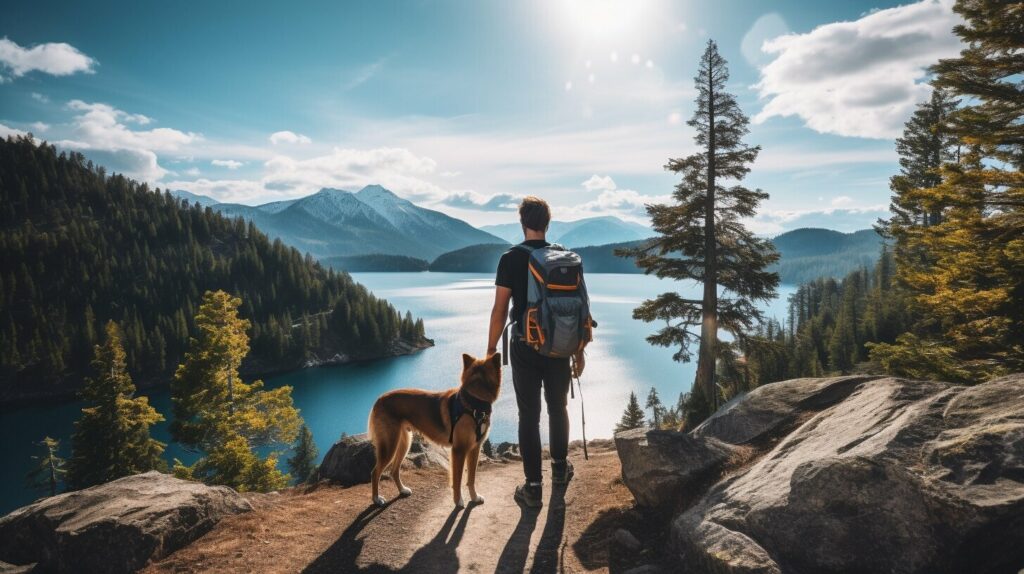Are you an outdoor enthusiast looking for a new adventure? Why not bring your furry companion along for the ride? Backpacking with dogs is a rewarding experience that strengthens the bond between owner and pet while enjoying the great outdoors.
Before hitting the trails, it’s essential to prepare adequately to ensure the safety and enjoyment of both you and your dog. This article will provide a comprehensive guide on how to backpack with dogs, including safety measures, tips for finding dog-friendly trails and campgrounds, training, packing essentials, camping arrangements, and more.
Key Takeaways
- Backpacking with dogs strengthens the bond between owner and pet while enjoying the great outdoors.
- Proper preparation is essential for the safety and enjoyment of both you and your dog.
- This article will provide a comprehensive guide on how to backpack with dogs, including safety measures, tips for finding dog-friendly trails and campgrounds, training, packing essentials, camping arrangements, and more.
Safety First: Preparing for Backpacking with Dogs
Backpacking with your furry friend can be an incredibly rewarding experience, but it’s important to prepare adequately to ensure the safety and enjoyment of both you and your dog. Here are some essential safety measures and preparations to consider before heading out on a backpacking trip with your dog:
Vaccinations
Make sure your dog is up-to-date on all of their vaccinations, especially rabies. It’s also a good idea to bring a copy of your dog’s vaccination records with you on the trip.
Training
Training your dog is crucial for a successful backpacking trip. Basic obedience commands like “sit,” “stay,” and “come” are essential. You’ll also want to work on leash training and socializing your dog with other dogs and people. If your dog has any specific behavioral issues, consider working with a professional trainer before embarking on your trip.
Gear and Supplies
Be sure to pack the necessary gear and supplies for your dog’s comfort and well-being. This includes a sturdy leash and collar, food and water bowls, high-quality dog food, plenty of water, a first aid kit, and any necessary medications. You may also want to consider purchasing a dog backpack to help distribute the weight of your dog’s supplies and gear.
Climate and Terrain
Take into account the climate and terrain of the area you’ll be backpacking in. Different breeds of dogs are better suited to different environments, so make sure your dog is physically capable of handling the conditions. You may also want to bring along extra gear like booties to protect your dog’s paws from rough terrain and weather conditions.
Emergency Preparedness
Plan for emergencies by bringing a fully-stocked first aid kit, a map and compass, and a GPS device or phone with a charged battery. You may also want to research local veterinary clinics and emergency services in case of an unexpected injury or illness.
By taking the necessary precautions and preparations, you can ensure a safe and enjoyable backpacking trip with your furry companion.
Choosing Dog-Friendly Trails and Campgrounds
When planning a backpacking trip with your furry friend, it is crucial to choose dog-friendly trails and campgrounds. Not all trails and campsites allow pets, and those that do may have specific rules and regulations to follow. Here are some tips for finding and selecting the right trails and campsites for your dog-friendly backpacking adventure.
Research Dog-Friendly Trails
Start by researching dog-friendly trails in the area you plan to visit. Look for information on the trail’s difficulty level, terrain, and length to ensure it is suitable for both you and your dog. Check for any trail closures, weather advisories, or restrictions that may affect your trip.
Some online resources for finding dog-friendly trails include:
- The BringFido app
- AllTrails.com
- DogTrekker.com
Evaluate the Trail
Once you have a list of potential trails, evaluate them with your dog in mind. Consider the terrain and whether your dog can handle the distance and elevation gain. Look for shady spots and water sources along the trail, especially if you plan to hike in hot weather.
Also, be aware of any potential hazards like steep drop-offs, rocky terrain, or poisonous plants that could harm your dog. Do your best to avoid any hazards, and keep your dog on a leash or under close supervision if necessary.
Check Campsite Rules and Regulations
When selecting a campsite, make sure to check the rules and regulations regarding pets. Some campsites may have specific areas designated for pets, while others may require dogs to be leashed or crated at all times. Follow these rules and always clean up after your dog to maintain a clean and safe environment for everyone.
Also, be respectful of other campers by keeping your dog under control and minimizing noise and disturbance. Consider bringing earplugs or noise-canceling headphones to avoid bothering others if your dog tends to bark or whine at night.
In conclusion, taking your dog on a backpacking adventure can be a rewarding and joyful experience, but it is essential to choose dog-friendly trails and campsites that are safe and suitable. Research and evaluate your options carefully, and always follow the rules and regulations to ensure a positive experience for everyone involved.
Training and Conditioning Your Dog for Backpacking
Before hitting the trail, it’s crucial to ensure that your furry friend is trained and conditioned for the rigors of backpacking. Even if your dog is well-behaved at home, the unfamiliar setting and physical demands of hiking can be overwhelming and potentially dangerous.
To get started, begin working with your dog on basic commands such as “come,” “stay,” and “leave it.” This will help keep your pup safe in the outdoors and prevent any accidents or encounters with wildlife.
Next, gradually build up your dog’s endurance through regular exercise. Start with short walks and hikes, gradually increasing the distance and difficulty over time. Pay attention to your dog’s behavior and adjust accordingly if they seem fatigued or uncomfortable.
It’s also important to ensure that your dog is up-to-date on their vaccinations and parasite prevention medication before heading out. This will protect them from potentially life-threatening illnesses and parasites that can be common in the outdoors.
Finally, consider any behavioral concerns your dog may have, such as anxiety or aggression towards other dogs. If necessary, consult with a professional trainer or behaviorist to address these issues before embarking on a backpacking trip.
By taking the time to train and condition your dog for backpacking, you can ensure a safe and enjoyable outdoor adventure for both you and your furry friend.
Packing Essentials for Your Dog’s Backpacking Adventure
When backpacking with your dog, it’s essential to pack the right gear to ensure their comfort and safety on the trail. Here’s a list of dog backpacking supplies you won’t want to leave behind:
- Dog Backpack: A properly fitting backpack will allow your pup to carry their own food, water, and gear. Be sure to gradually increase the weight they carry and always distribute weight evenly.
- Food: Pack enough food for your dog’s energy needs, plus extra in case of emergencies. Opt for lightweight, high-calorie food that’s easy to store and won’t spoil.
- Water and Bowl: Bring plenty of clean water and a collapsible bowl for your dog to drink from. Consider bringing a water filtration system for longer trips.
- Collar and Leash: Make sure your dog always wears a collar with identification tags and bring a sturdy leash for control on the trail.
- First Aid Kit: Include basic first aid supplies, such as bandages, tweezers, and antiseptic, as well as any necessary medications for your dog.
Other items to consider include a comfortable sleeping pad, reflective gear for nighttime visibility, and a jacket for colder weather. When packing for your dog, keep in mind their weight and comfort, as well as any restrictions or aches they may have.
Considerations for Camping and Sleeping Arrangements
When backpacking with your dog, it is important to consider your camping and sleeping arrangements to ensure a safe and comfortable trip for both you and your furry friend. Here are some important factors to keep in mind:
- Tent selection: Make sure to choose a tent that is large enough to comfortably accommodate both you and your dog. Look for tents with enough space for your dog to move around and sit up without feeling cramped. If you have a larger dog, consider a tent with a vestibule or extra space to store gear.
- Sleeping arrangements: Invest in a good quality sleeping pad or dog bed to keep your furry friend comfortable and warm at night. It is also a good idea to bring a blanket or sleeping bag to cover your dog for extra warmth, especially on cooler nights.
- Campsite etiquette: When camping with your dog, be mindful of other campers and their pets. Keep your dog on a leash at all times, clean up after them promptly, and avoid letting them disturb others with excessive barking or digging.
By considering these factors and planning ahead, you can ensure a peaceful and enjoyable camping experience for both you and your dog.
Enjoying the Great Outdoors with Your Dog
Embarking on a backpacking adventure with your furry friend can be an incredibly rewarding experience. Not only do you get to enjoy the beautiful outdoors together, but your dog also provides an extra sense of security and companionship on the trail. Here are some tips for making the most of your outdoor adventure with your dog:
- Take plenty of breaks. While you may be focused on reaching your destination, it’s important to take regular breaks for rest and water. This is especially true for your dog, who may not be accustomed to extended hikes.
- Let your dog lead the way. Allow your dog to take the lead and explore the trail at their own pace. This will not only keep them engaged and entertained, but it’s also a great way to help them get exercise and prevent boredom.
- Bring along some toys. Bringing along some toys can help keep your dog entertained during breaks and downtime. It’s also a great way to bond with your dog and enjoy some playtime together.
It’s important to be aware of potential hazards on the trail, including wildlife, other dogs, and hazardous terrain. Keep your dog on a leash when necessary and be prepared to handle any unexpected encounters. By following these tips, you and your furry friend can enjoy a safe and enjoyable backpacking experience together.
Nourishing Your Dog on the Trail
Proper nutrition is essential for your dog’s health and energy during backpacking trips. Here are some tips for providing the right food for your furry friend:
- Choose high-quality, nutrient-dense dog food that is appropriate for your dog’s age, size, and activity level.
- Consider freeze-dried or dehydrated dog food, which is lightweight and easy to pack for the trail.
- Bring enough food for the entire trip, plus a little extra just in case. Plan for at least one to two cups of food per day.
- Avoid feeding your dog table scraps or unfamiliar foods, which can upset their stomachs and lead to digestive issues.
- Make sure your dog has access to plenty of fresh, clean water throughout the trip. Bring a collapsible water bowl and filter for natural water sources.
- If your dog has dietary restrictions or special needs, consult with your veterinarian before the trip to develop a suitable feeding plan.
- Practice Leave No Trace principles by packing out your dog’s waste and disposing of it properly.
By providing your dog with the right nutrition on the trail, you can ensure that they have the energy and stamina to enjoy the adventure with you.
Safety Tips and Emergency Preparedness
Backpacking with your dog can be an unforgettable experience, but it’s important to be prepared for any potential emergencies. Here are some safety tips and emergency preparedness guidelines to keep in mind:
First Aid and Emergency Supplies
Pack a first aid kit specifically for your dog that includes supplies such as gauze, bandages, hydrogen peroxide, tweezers, and antiseptic wipes. Carry a map and compass, and make sure you know how to use them in case you get lost. Also, keep emergency contact information handy, such as your veterinarian’s contact information, and research local emergency veterinary clinics in the area you plan to hike.
Recognize Signs of Distress or Illness
As you hike with your dog, keep a close eye on them. It’s essential to recognize when your dog might be in distress or showing signs of illness. Common signs include excessive panting, drooling, vomiting, diarrhea, and reluctance to move. If you notice any of these, it’s time to rest and rehydrate. If symptoms persist, return home or seek veterinary care.
Responding to an Emergency
If an accident or emergency happens, your dog’s safety is paramount. Stay calm and assess the situation. If your dog is injured, do not move them unless absolutely necessary. Immobilize the injured area and use your first aid kit to stabilize them. If you need to evacuate, carry your dog carefully, making sure not to exacerbate any injuries.
Remember to stay alert and be prepared for any situation when backpacking with your dog. With the right preparation and precautions, you can enjoy the great outdoors with your furry friend safely and responsibly.
Conclusion
In conclusion, backpacking with your dog is a rewarding and fulfilling experience that can strengthen your bond and provide endless opportunities for outdoor adventures. By following the essential safety measures and preparations, choosing dog-friendly trails and campgrounds, training and conditioning your dog, packing the necessary supplies, and practicing responsible and safe practices on the trail, you can embark on a memorable backpacking journey with your furry friend.
Remember to properly feed and nourish your dog on the trail, and always be prepared for emergency situations. By prioritizing your dog’s comfort, well-being, and safety, you can make the most out of your dog-friendly backpacking trip.
Happy Trails with Your Furry Friend!
FAQ
Q: Can I go backpacking with my dog?
A: Yes, you can go backpacking with your dog. It can be a great adventure for both you and your furry friend.
Q: How do I prepare for backpacking with my dog?
A: To prepare for backpacking with your dog, make sure they are up to date on vaccinations, train them to follow basic commands, and gather the necessary gear and supplies for their comfort and safety.
Q: How do I find dog-friendly trails and campgrounds?
A: To find dog-friendly trails and campgrounds, do some research online, read reviews, and check the rules and regulations of the trails and campgrounds you are interested in.
Q: How do I train and condition my dog for backpacking?
A: To train and condition your dog for backpacking, gradually increase their endurance through regular exercise, teach them basic commands, and address any behavioral concerns that may arise on the trail.
Q: What should I pack for my dog’s backpacking adventure?
A: When packing for your dog’s backpacking adventure, make sure to include food, water, first aid supplies, safety gear, and comfort items. Be mindful of properly distributing weight in your dog’s backpack.
Q: How should I handle camping and sleeping arrangements with my dog?
A: When camping with your dog, choose a suitable tent, make comfortable sleeping arrangements, and follow proper etiquette when sharing camping spaces with other campers and their pets.
Q: How can I enjoy outdoor activities with my dog while backpacking?
A: You can enjoy outdoor activities with your dog while backpacking by providing them with exercise, playtime, and opportunities to explore nature. Be prepared for encounters with wildlife and other dogs on the trail.
Q: What should I feed my dog while backpacking?
A: While backpacking, feed your dog suitable food that meets their energy needs. Consider any dietary restrictions they may have and be mindful of handling waste on the trail.
Q: What safety tips and emergency preparedness should I be aware of?
A: Be aware of safety tips and emergency preparedness guidelines for backpacking with dogs. Learn first aid for dogs, recognize signs of distress or illness, and know what to do in case of an emergency or injury.



